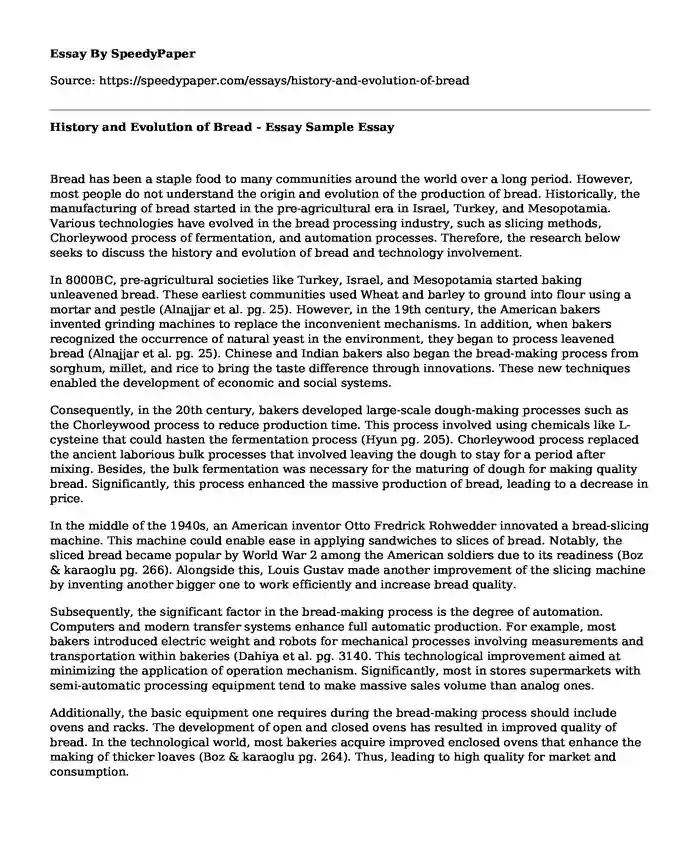
| Type of paper: | Essay |
| Categories: | Food |
| Pages: | 3 |
| Wordcount: | 669 words |
Bread has been a staple food to many communities around the world over a long period. However, most people do not understand the origin and evolution of the production of bread. Historically, the manufacturing of bread started in the pre-agricultural era in Israel, Turkey, and Mesopotamia. Various technologies have evolved in the bread processing industry, such as slicing methods, Chorleywood process of fermentation, and automation processes. Therefore, the research below seeks to discuss the history and evolution of bread and technology involvement.
In 8000BC, pre-agricultural societies like Turkey, Israel, and Mesopotamia started baking unleavened bread. These earliest communities used Wheat and barley to ground into flour using a mortar and pestle (Alnajjar et al. pg. 25). However, in the 19th century, the American bakers invented grinding machines to replace the inconvenient mechanisms. In addition, when bakers recognized the occurrence of natural yeast in the environment, they began to process leavened bread (Alnajjar et al. pg. 25). Chinese and Indian bakers also began the bread-making process from sorghum, millet, and rice to bring the taste difference through innovations. These new techniques enabled the development of economic and social systems.
Consequently, in the 20th century, bakers developed large-scale dough-making processes such as the Chorleywood process to reduce production time. This process involved using chemicals like L-cysteine that could hasten the fermentation process (Hyun pg. 205). Chorleywood process replaced the ancient laborious bulk processes that involved leaving the dough to stay for a period after mixing. Besides, the bulk fermentation was necessary for the maturing of dough for making quality bread. Significantly, this process enhanced the massive production of bread, leading to a decrease in price.
In the middle of the 1940s, an American inventor Otto Fredrick Rohwedder innovated a bread-slicing machine. This machine could enable ease in applying sandwiches to slices of bread. Notably, the sliced bread became popular by World War 2 among the American soldiers due to its readiness (Boz & karaoglu pg. 266). Alongside this, Louis Gustav made another improvement of the slicing machine by inventing another bigger one to work efficiently and increase bread quality.
Subsequently, the significant factor in the bread-making process is the degree of automation. Computers and modern transfer systems enhance full automatic production. For example, most bakers introduced electric weight and robots for mechanical processes involving measurements and transportation within bakeries (Dahiya et al. pg. 3140. This technological improvement aimed at minimizing the application of operation mechanism. Significantly, most in stores supermarkets with semi-automatic processing equipment tend to make massive sales volume than analog ones.
Additionally, the basic equipment one requires during the bread-making process should include ovens and racks. The development of open and closed ovens has resulted in improved quality of bread. In the technological world, most bakeries acquire improved enclosed ovens that enhance the making of thicker loaves (Boz & karaoglu pg. 264). Thus, leading to high quality for market and consumption.
In conclusion, there is a need to understand the history and evolution of bread using technology. The research question was intended to enable a better understanding of this matter. It is a clear indication from the past that the making of bread began in the Middle East, and later, India and China joined bred making. Various improvements have occurred within the industry, such as slicing techniques, ovens, Chorleywood process, and automation processes. This research recommends bakers to consider the history and these new inventions regarding bread making.
References
Alnajjar, Safwan, and Khalid Dawod. "Correlation and path coefficient analysis in bread wheat." Mesopotamia journal of agriculture, vol 48, no. 1, 2020, p. 25. The University Of Mosul, doi:10.33899/magrj.2020.126461.1019.
Boz, H., and M.M. Karaoglu. "Improving the quality of whole wheat bread by using various plant origin materials." Czech Journal of food sciences, vol 31, no. No. 5, 2013, p. 466. Czech Academy of Agricultural Sciences, doi:10.17221/410/2012-chefs.
Dahiya, Seema et al. "A review on biotechnological potential of multifarious enzymes in bread making." Process Biochemistry, 2020, p. 314. Elsevier BV, doi:10.1016/j.procbio.2020.09.002.
Hyun Jong. "Analysis for consumers' opinion regarding domestic Wheat Bread." Journal of consumer policy studies, null, no. 40, 2011, p. 205. Korea Consumer Agency, doi:10.15723/jcps..40.201110.205.
Cite this page
History and Evolution of Bread - Essay Sample. (2023, Dec 15). Retrieved from https://speedypaper.net/essays/history-and-evolution-of-bread
Request Removal
If you are the original author of this essay and no longer wish to have it published on the SpeedyPaper website, please click below to request its removal:
- Food and Health Essay Samples
- Truffles Essay Example
- Should Fast Food or Unhealthy Foods Be Taxed Heavily? Free Essay for You
- Essay Example: Health Benefits of Citrus Fruits
- Comparison Essay Example on Vegetarians and Non-Vegetarians Diets
- Nutrition Essay Sample: Properties that make Vegan Menus better than Vegetarian Intake
- How to Make a Smoked Beef Brisket - Process Analysis Essay Sample
Popular categories




